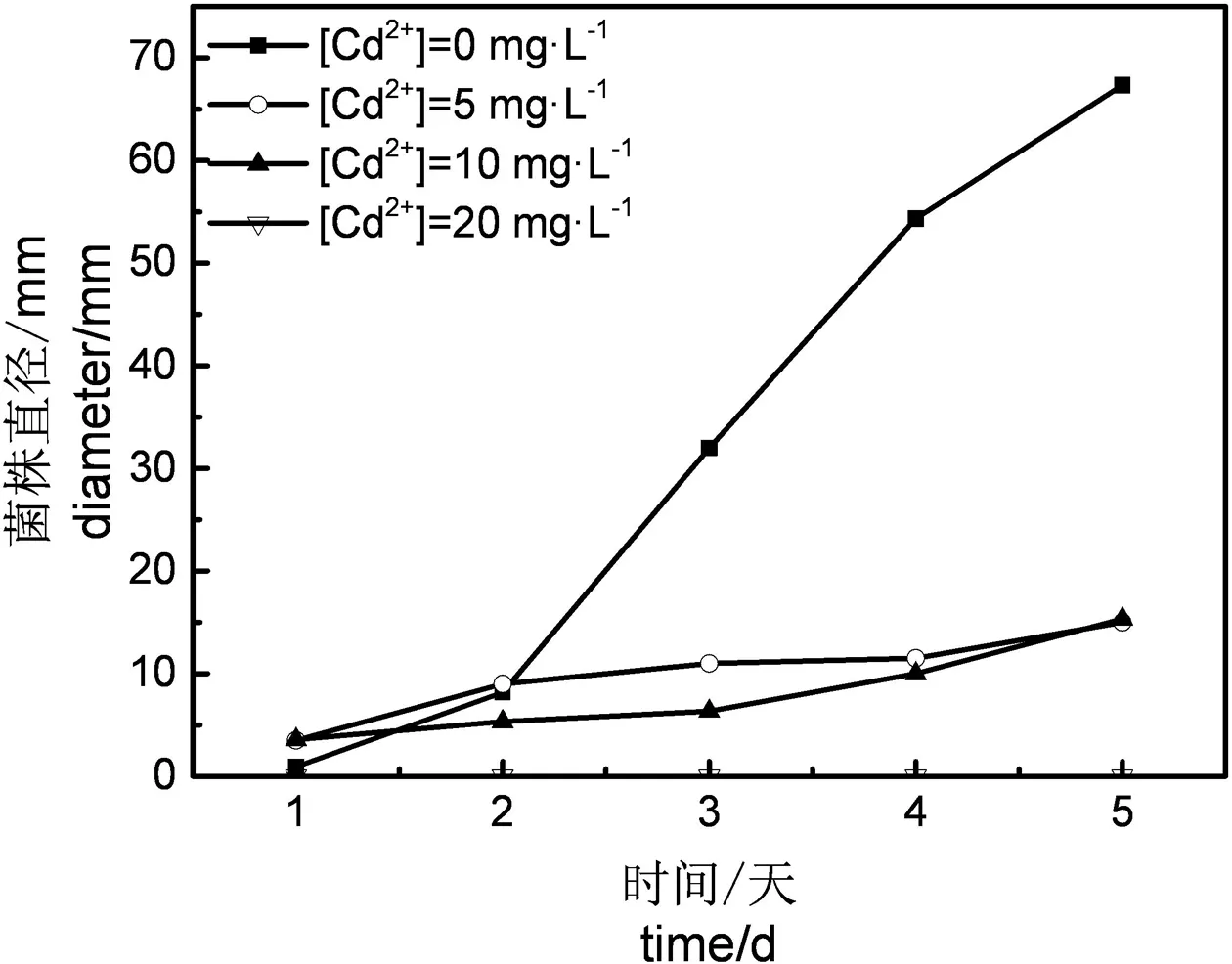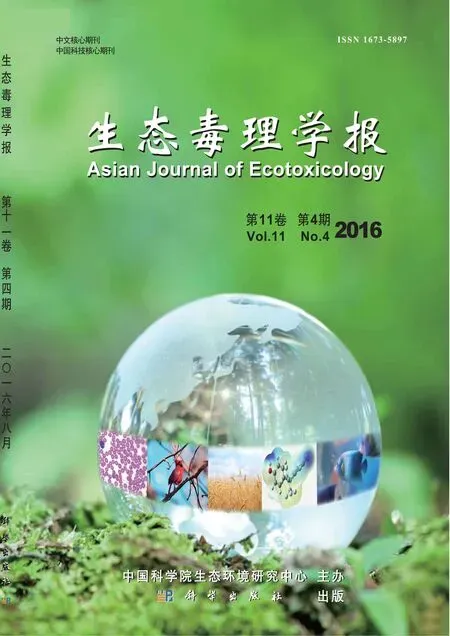重金属对禾谷镰刀菌的生长及毒素合成的影响
杨文杰,孙长坡,孙运海,姚瑞华,孙宏亮,马乐宽,*
1. 环境保护部环境规划院,北京 100012 2. 国家粮食局科学研究院,北京 100037
重金属对禾谷镰刀菌的生长及毒素合成的影响
杨文杰1,孙长坡2,孙运海1,姚瑞华1,孙宏亮1,马乐宽1,*
1. 环境保护部环境规划院,北京 100012 2. 国家粮食局科学研究院,北京 100037
以禾谷镰刀菌为研究对象,研究了常见重金属(Cu、Pb、Zn、Cd)对禾谷镰刀菌菌株生长及其毒素合成的影响。研究结果表明,重金属对菌株的生长和其产毒能力均产生影响。Cu2+和Cd2+对菌株生长影响较大,随着浓度的增加对生长的抑制作用增强,当离子浓度分别为20 mg·L-1和40 mg·L-1时,能够完全抑制菌株生长。Zn2+在0~160 mg·L-1浓度范围内促进菌株生长,在10 mg·L-1浓度下促进毒素合成。Pb2+在察氏培养基中对菌株生长的影响没有明显规律可循,但是,随着Pb2+浓度增加,抑制毒素合成作用增强。
重金属;产毒素真菌;菌落直径;玉米赤霉烯酮
目前,农田土壤重金属污染日益突出。由于其在介质中移动性差,滞留时间长,不能被微生物降解,具有隐蔽性、长期性和不可逆的特点[1],且可以通过食物链进入人体,潜在危害大[2],所以农田土壤的重金属污染已逐渐引起大家的重视。但是,现有研究鲜有关于重金属对农产品中真菌毒素产生的影响。选取禾谷镰刀菌作为供试菌株,研究重金属对其生长和毒素产生的影响。玉米赤霉烯酮(zearalenone,ZEN)是禾谷镰刀菌的代谢产物[3]。粮食作物在生长过程后期或粮食在运输和储存过程中,由于温度、湿度等环境因素变化,可能导致玉米、水稻、麦类等谷物的禾谷镰刀菌浸染并导致ZEN污染,其可以通过食物链富集,最终威胁人体健康[4]。2011年10月20日开始实施的食品安全国家标准GB 2761—2011《食品中真菌毒素限量》中规定:玉米赤酶烯酮在谷物中的限量为60 mg·kg-1。由于其在自然界污染的普遍性和广泛的毒性作用,被给予了充分关注。ZEN生物毒性强,控制其在谷物中的含量对保证人体健康以及畜牧养殖等尤为重要[5]。
虽然粮食中的重金属污染和真菌及其毒素污染一直是国内外学者研究的热点,但至今为止,国内外研究主要集中于粮食中重金属和毒素的单一污染,鲜有关于重金属对粮食中真菌及其毒素合成影响的研究。因此,本文尝试探讨重金属对禾谷镰刀菌及其产毒素的影响,以探讨粮食中的重金属污染对产毒素真菌的生长和其产生毒素能力的影响,为谷类粮食作物的多污染防控提供理论支持。
1 材料与方法(Materials and methods)
1.1 实验材料
供试菌株:禾谷镰刀菌株(Fusarium graminearum),国家粮食局粮食科学研究院提供;供试重金属:Cd(NO3)2,Cu(NO3)2,Zn(NO3)2,Pb(NO3)2,上述试剂均为分析纯,购自北京化学试剂厂;玉米粉为普通玉米粉,购于中国农业科学院。
察氏培养基:根据文献所述配制真菌培养基[6],蔗糖,NaNO3,K2HPO4,KCl,MgSO4·7H2O,FeSO4,蒸馏水,加入1.0 mL浓度为0.1%的FeSO4溶液,混匀后分装灭菌。如需要固体培养基,则在灭菌前加入0.2%的琼脂粉。
玉米培养基:150 mL锥形瓶中加20 g玉米粉,密封后于121 ℃灭菌20 min,冷却至室温后加入30 mL无菌水,充分混合。按需加入待测金属溶液。
1.2 实验方法
1.2.1 重金属对菌株生长影响
实验设置不同浓度重金属对禾谷镰刀菌进行处理。在无菌操作条件下,采用接种环点种法接种菌株。接种完成的培养基置于31 ℃恒温培养箱中培养。在菌株生长1、2、3、4、5 d时,采用十字交叉法[7]测量菌落直径,每组实验设置3个平行,计算各处理组的单株平均值,作为各组菌落的直径。
1.2.2 重金属对毒素合成的影响
实验设置不同浓度重金属对禾谷镰刀菌进行处理。配制含不同重金属浓度的玉米培养基,接种菌液,每组实验设置3个平行。暗光下于25 ℃在生化培养箱中培养1周,再将温度调至20 ℃培养3周,提取并使用高效液相色谱法[8]测定培养液毒素量。
2 结果与讨论 (Results and discussion)
2.1 菌株的生长情况
根据微生物不同生长时期的菌落直径变化趋势,绘制了禾谷镰刀菌生长曲线。菌株生长曲线结果如图1~图4所示。

图1 Zn2+处理下的禾谷镰刀菌菌株生长曲线(菌落直径)Fig. 1 Effects of Zn2+ on the strain growth of Fusarium graminearum (colony diameter)
从不同浓度Zn2+处理下菌株的生长曲线(图1)可以看出,不同Zn2+浓度处理下,菌落的直径随着时间的变化均呈现上升趋势。生长5 d后的菌落直径随着Zn2+浓度的增加其增长趋势逐渐趋缓,表现出一定的激活-抑制效应。结果表明,Zn2+浓度在0 ~160 mg·L-1时,对禾谷镰刀菌的生长起促进作用。随着Zn2+浓度的增加,当Zn2+浓度大于640 mg·L-1时,禾谷镰刀菌生长5 d后的菌落直径小于空白组,开始表现为抑制作用,并且随着Zn2+浓度的增加抑制作用增强。其原因可能是: Zn2+是微生物必需的营养微量元素之一[9],对真菌的生长起促进作用,能够增加菌株干物质的积累。孟丽等[10]在研究Zn2+处理对真菌生长发育的影响中也发现了类似的规律。本研究结果还表明,高浓度Zn2+处理对禾谷镰刀菌生长起抑制作用,其原因可能是高浓度的Zn2+对菌株具有一定的毒性。聂湘平等[11]在研究中也发现高浓度的Zn2+处理对真菌有抑制效应。


图2 Pb2+处理下的禾谷镰刀菌菌株生长曲线(菌落直径)Fig. 2 Effects of Pb2+ on the strain growth of Fusarium graminearum (colony diameter)

图3 Cd2+处理下的禾谷镰刀菌菌株生长曲线(菌落直径)Fig. 3 Effects of Cd2+ on the strain growth of Fusarium graminearum (colony diameter)
图3为不同浓度Cd2+处理下菌株的生长曲线,可以看出,随着Cd2+处理浓度的增加,生长5 d后的菌落直径明显下降,说明Cd2+抑制了菌体的正常生长,呈现剂量-效应关系[14]。当Cd2+浓度达到20 mg·L-1时,能够完全抑制菌株生长,与李勇等[12]研究结果一致。其原因可能是重金属离子与酶或其他大分子物质结合,导致生物个体病变和死亡。谢燕等[15]的研究也发现了类似现象。

图4 Cd2+处理下的禾谷镰刀菌菌株生长曲线(菌落直径)Fig. 4 Effects of Cu2+ on the strain growth of Fusarium graminearum (colony diameter)
从不同浓度Cu2+处理下菌株的生长曲线可以看出,随着Cu2+浓度的增加,生长5 d后的菌落直径逐渐减小,Cu2+对菌株的生长抑制作用增强,当Cu2+浓度达到40 mg·L-1时,能够完全抑制禾谷镰刀菌的生长。本研究与杨瑞恒等[16]和Muccifora等[17]的研究结果一致。其原因可能是由于Cu2+是一种杀菌剂[18],具有很强的杀菌能力。洪法水等[19]的研究表明,由于真菌对金属的选择性吸收,使得某些特定的金属离子具有很强的杀菌能力。
2.2 重金属对ZEN合成的影响
本研究中实验所用玉米粉中原有的重金属含量忽略不计。重金属对毒素合成的影响结果如表1所示。

表1 不同浓度重金属下玉米赤霉烯酮(ZEN)毒素的合成
从表1中可以看出,Pb2+、Cu2+和Cd2+处理组中菌株的毒素合成均小于空白对照组,表现为抑制作用,并且随着金属离子浓度的增加,ZEN含量呈现下降趋势,对菌株毒素合成的抑制作用增强,和Pb2+、Cu2+和Cd2+对菌株生长的影响规律一致。加入Zn2+的玉米培养基中,随着Zn2+浓度的增加,ZEN的含量呈现先上升后下降的趋势,与孙建和等[20]的研究结果一致。当Zn2+浓度为10 mg·L-1时,ZEN的含量大于空白组,表现为促进菌株毒素的合成,其原因可能是由于锌是微生物体营养类微量元素,在适宜浓度的Zn2+处理下能显著提高孢子存活率,郝俊冉[21]的研究结果也得到了相同的结论。低浓度Zn2+(10 mg·L-1)对真菌毒素的合成起到促进作用,所以控制锌污染力度应加强,因为出现锌污染的区域很可能同时存在较重的真菌和真菌毒素污染。综合以上研究结果可以看出,在Cu2+、Zn2+和Cd2+作用下,菌株产生的毒素含量和菌株的生长呈正相关,和郭新梅等[22]研究结果一致。原因之一可能是由于重金属促进或抑制了酶活性,从而影响了菌株的生长和代谢。虽然随培养体系重金属含量增加,真菌毒素下降,但是并不能直接说明谷物重金属污染可以降低ZEN的污染风险。环境重金属污染对谷物的影响以及对产毒真菌的影响之间相关性问题还需深入研究。
[1] Lei M, Tie B Q, Song Z G, et al. Heavy metal pollution and potential health risk assessment of white rice around mine areas in Hunan Province, China [J]. Food Security, 2015, 7(1): 45-54
[2] Islam E U, Yang X E, He Z L, et al. Assessing potential dietary toxicity of heavy metals in selected vegetables and food crops [J]. Journal of Zhejiang University: Science B, 2007, 8(1): 1-13
[3] Ramos A J, Marín S, Sanchis V, et al. Fusarium verticillioides and Fusarium graminearum infection and fumonisin B1 and zearalenone accumulation in resveratrol-treated corn [J]. Food Science and Technology International, 2006, 12(4): 353-359
[4] Czeh A. A flow cytometry based competitive fluorescent microsphere immunoassay (CFIA) system for detecting up to six mycotoxins [J]. Journal of Immunological Methods, 2012, 384: 71-80
[5] Zinedine A, Soriano J M, Moltó J C, et al. Review on the toxicity, occurrence, metabolism, detoxification, regulations and intake of zearalenone: An oestrogenic mycotoxin [J]. Food and Chemical Toxicology, 2007, 45(1): 1-18
[6] 钱存柔. 微生物学实验教程[M]. 北京:北京大学出版社, 1999: 56-58
Qian C R. Laboratory Experiments in Microbiology [M]. Beijing: Peking University Press, 1999: 56-58 (in Chinese)
[7] 杨焕青, 王开运, 范昆, 等. 草莓枯萎病菌的生物学特性及7种杀菌剂对其抑制作用[J]. 植物保护学报, 2008, 35(2): 169-174
Yang H Q, Wang K Y, Fan K, et al. Biological characteristics of strawberry Fusarium wilt and inhibitory effects of seven fungicides [J]. Acta Phytophylacica Sinica, 2008, 35(2): 169-174 (in Chinese)
[8] 王裕中. 中国小麦赤霉病菌优势种——禾谷镰刀菌产毒素能力的研究[J]. 真菌学报, 1994(3): 229-234
Wang Y Z. Toxin producing potential of Fusarium graminearum from China [J]. Acta Mycologica Sinica, 1994(3): 229-234 (in Chinese)
[9] Stefanidou M. Zinc: A multipurpose trace element [J]. Archives of Toxicology, 2006, 80(1): 1-9
[10] 孟丽, 简在友, 李孝伟, 等. 金银花藤培养基中加锌对香菇菌丝生长的影响[J]. 湖北农业科学, 2007, 46(2): 251-252
Meng L, Jian Z Y, Li X W, et al. Effect of honeysuckle rattan-Zn2+medium on the growth of Lentinusedodes hypha [J]. Hubei Agricultural Sciences, 2007, 46(2): 251-252(in Chinese)
[11] 聂湘平, 蓝崇钰, 束文圣, 等. 锌对大叶相思-根瘤菌共生固氮体系影响研究[J]. 植物生态学报, 2002, 26(3): 264-268
Nie X P, Lan C Y, Shu W S, et al. Effects of zinc on Rhizobia-earleaf acacia (Acacia auriculaeformis) symbiotic association [J]. Acta Phytophylacica Sinica, 2002, 26(3): 264-268 (in Chinese)
[12] 李勇, 黄占斌, 王文萍, 等. 重金属铅镉对玉米生长及土壤微生物的影响[J]. 农业环境科学学报, 2009, 28(11): 2241-2245
Li Y, Huang Z B, Wang W P, et al. Effects of heavy metals lead and cadmium on Zea mays L. growth and the soil microorganism [J]. Journal of Agro-environment Science, 2009, 28(11): 2241-2245 (in Chinese)
[13] 王亮. 白腐真菌胞外聚合物的产量、组分及其对菌体吸附铅的机理研究[D]. 长沙: 湖南大学, 2011
Wang L. Yield and composition of extracellular polymeric substances (EPS) by white-rot fungi and mechanism of its biosorption of Pb2+[D]. Changsha: University of South China, 2011 (in Chinese)
[14] 刘慧, 张宇宏, 张少斌, 等. Cd2+胁迫对螺旋藻生长、光谱特性及藻胆蛋白质量浓度的影响[J]. 生态环境, 2007, 16(3): 767-770
Liu H, Zhang Y H, Zhang S B, et al. Effects of Cd2+on the growth, spectroscopic properties and phycobiliprotein content of Spirulina platensis [J]. Ecology and Environment, 2007, 16(3): 767-770 (in Chinese)
[15] Yan X, Luo H, Du Z, et al. Identification of cadmium-resistant fungi related to Cd transportation in bermudagrass. Cynodon dactylon (L.) Pers [J]. Chemosphere, 2014, 117: 786-792
[16] 杨瑞恒, 姚青, 郭俊, 等. 磷和镉对根内球囊霉Glomus intraradices孢子萌发、菌丝生长和外生菌丝内聚磷酸累积的影响[J]. 菌物学报, 2010, 29(3): 421-428
Yang R H, Yao Q, Guo J, et al. Influence of P and Cd on the spore germination, hyphal growth and polyphosphate accumulation in extraradical hyphae of Glomus intraradices [J]. Mycosystema, 2010, 29(3): 421-428 (in Chinese)
[17] Muccifora S. Effects of copper on spore germination, growth and ultrastructure of Polypodium cambricum L. gametophytes [J]. Environmental Pollution, 2008, 153(2): 369-375
[18] Viti C,Quaranta D, Philippis R D, et al. Characterizing cultivable soil microbial communities from copper fungicide-amended olive orchard and vineyard soils [J]. World Journal of Microbiology & Biotechnology, 2007, 24(3): 309-318
[19] 洪法水, 王雪峰, 吴康, 等. 重金属离子对猪胰α-淀粉酶活性影响的作用机理研究[J]. 高等学校化学学报, 2001, 22(12): 1979-1983
Hong F S, Wang X F,Wu K, et al. Mechanism of heavy metal ions on α-amylase activity from porcine pancreas [J]. Chemical Journal of Chinese Universities, 2001, 22(12): 1979-1983 (in Chinese)
[20] 孙建和, 陆苹, 顾红香, 等. 真菌毒素的微生物脱毒技术[J]. 微生物学通报, 2003, 30(1): 60-63
Sun J H, Lu P, Gu H X, et al. Microbial detoxification of mycotoxins technology [J]. Microbiology, 2003, 30(1): 60-63 (in Chinese)
[21] 郝俊冉. 谷胱甘肽和锌离子缓解赭曲霉毒素A毒性的组学研究[D]. 北京:中国农业大学, 2015
Hao J R. Omics analysis on mechanisms of glutathione and zinc ion in relieving ochratoxin A-induced toxicity [D]. Beijing: China Agricultural University, 2015 (in Chinese)
[22] 郭新梅, 陈耀锋, 李春莲, 等. 禾谷镰刀菌粗毒素对不同小麦品种幼苗MDA含量和SOD、PAL活性的影响 [J]. 西北植物学报,2007, 27(1): 68-73
Guo X M, Chen Y F, Li C L, et al. Effects of Fusarium graminearum crude toxin on MDA contents and SOD and PAL activities in the seedlings of different wheat varieties [J]. Acta Botanica Boreali-Occidentalia Sinica, 2007, 27(1): 68-73 (in Chinese)
Influence of Heavy Metals on the Growth and Toxin Synthesis of Fusarium graminearum
Yang Wenjie1,Sun Changpo2,Sun Yunhai1,Yao Ruihua1,Sun Hongliang1,Ma Lekuan1,*
1. Chinese Academy for Environmental Planning, Beijing 100012, China 2. Academy of State Administration of Grain, Beijing 100037, China
Received 3 March 2016 accepted 9 May 2016
Effects of heavy metals including Cu, Cd, Zn and Pb on the strain growth and toxin synthesis of Fusarium graminearum were investigated. The results indicated that the concentration and type of heavy metals had impact on the growth and toxin synthesis of the strain. The growth of the strain was inhibited increasingly with the increase of Cu2+and Cd2+concentrations in the culture media, and no growth was observed when the concentrations reached 20 mg·L-1and 40 mg·L-1, respectively. The growth of the strain was promoted under the Zn2+treatment with the concentration ranging from 0 mg·L-1to 160 mg·L-1, but the toxin synthesis was promoted within 10 mg·L-1. The effect of Pb2+on the growth of the strain was not well-regulated, but the inhibition of toxin synthesis was enhanced with the increase of Pb2+concentration.
heavy metals; mycotoxins; colony diameter; zearalenone
杨文杰(1980-),女,助理研究员,研究方向为水污染防治,E-mail: wjyang1109@126.com;
*通讯作者(Corresponding author), E-mail: malk@caep.org.cn
10.7524/AJE.1673-5897.20160303002
2016-03-03 录用日期:2016-05-09
1673-5897(2016)4-211-05
X171.5
A
简介:马乐宽(1978—),男,博士,副研究员,主要研究方向为水污染防治。
杨文杰,孙长坡,孙运海, 等. 重金属对禾谷镰刀菌的生长及毒素合成的影响[J]. 生态毒理学报,2016, 11(4): 211-215
Yang W J, Sun C P, Sun Y H, et al. Influence of heavy metals on the growth and toxin synthesis of Fusarium graminearum [J]. Asian Journal of Ecotoxicology, 2016, 11(4): 211-215 (in Chinese)

